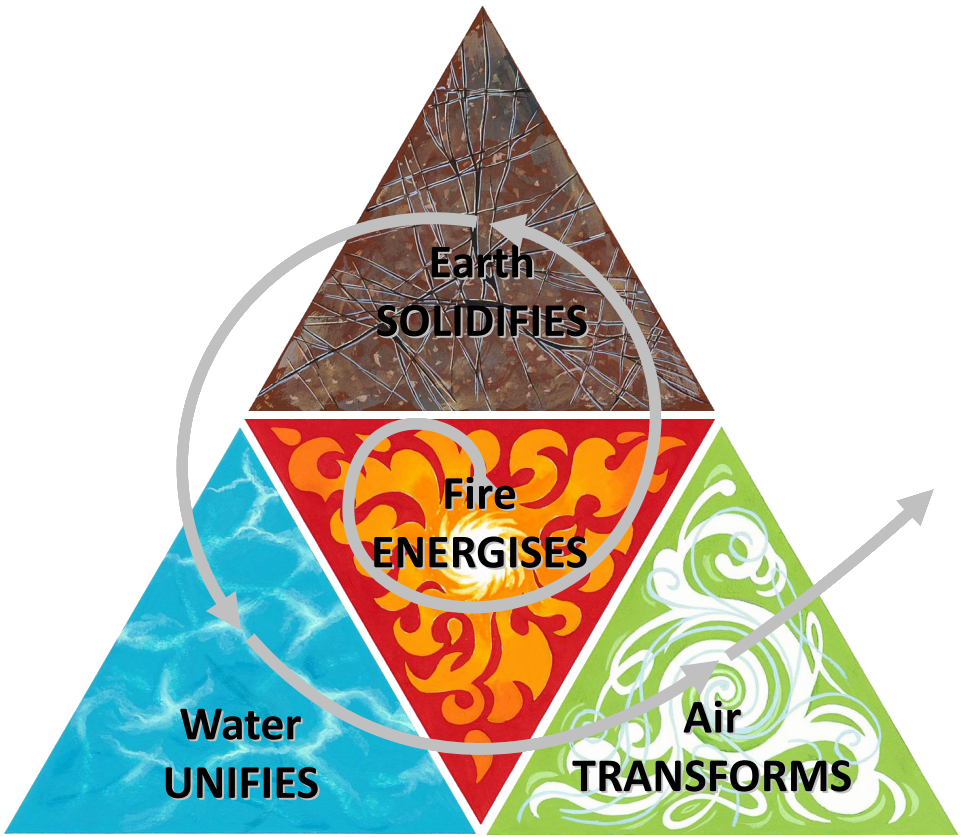Functions Spiral
How Whole Systems Spiral Through Four Interdependent Functions

Whole-systems thinking considers the metaphors:
Fire: How/what the whole system ENERGISES
Earth: How/what the wholesystem SOLIDIFIES
Water: How/what the whole system UNIFIES
Air: How/what the whole system TRANSFORMS
Emérgéntly uses metaphor to map complex systems and to bridge between linear thinking and non-linear, whole systems thinking. However, remember:
- The map is not the territory. (Alfred Korzybski)
- A logical sequence may vary in reality.
Now imagine the triangles folding into a tetrahedron...
 Notice how each element folds into each other element with the edges representing the interdependent relationships. Emérgéntly helps to visualise the relationships and interdependencies between the functional elements of a whole system. Like the elements of a leaf, the real value is in the relationships between the energy from sun, the minerals from the earth, the flow of water, and the transformation of carbon dioxide from the air into hydrocarbons and oxygen.
Notice how each element folds into each other element with the edges representing the interdependent relationships. Emérgéntly helps to visualise the relationships and interdependencies between the functional elements of a whole system. Like the elements of a leaf, the real value is in the relationships between the energy from sun, the minerals from the earth, the flow of water, and the transformation of carbon dioxide from the air into hydrocarbons and oxygen.
- an inside and an outside, reminding us to always consider the context outside the system.
- no opposite sides, reminding us to avoid polarised thinking in terms of strengths and weaknesses.
- four sides and six edges, reminding us to always consider the multiple relationships between the different functions of the system.
- at least one side not visible at any one time, reminding us to always consider the implicit - what we cannot see.
The tetrahedron reflects how the elements of Nature are:
- Diverse. There are no opposite sides. Each side is just different.
- Synergistic. The whole is greater than the sum of its parts e.g. the four sided tetrahedron is much stronger than the six sided cube.
- Structured. There is a recognisable pattern of relationships between its different sides.
- Interdependent. Each side of the tetrahedron touches every other side. No side is independent from any other side.
The above graphics and text by Yoshimi & Jon Brett are marked with CC0 1.0 (OK to copy)
The greatest thing by far is to be a master of metaphor
It is a sign of genius, since a good metaphor implies an intuitive perception of the similarity in dissimilars.
Aristotle
For the physicists and mathematicians, the tetrahedron is a metaphor for what David Bohm calls the Implicate Order, and the unfolded Emérgéntly Spiral is a metaphor for the Explicate Order.
...the metaphoric intelligence (if we may so tentatively label this set of capacities) is defined by the very capacity to integrate diverse intelligences.
H. Gardner 1983
Metaphor provides a way of unifying the disparate and ordering the complex. It provides a deeper understanding of behaviours that becomes a tipping point to significantly impact productivity, systems, work cultures, and vision.
From TetraMap: develop people and business the way Nature intended by Yoshimi and Jon Brett
See also:
- Project Drawdown Worlds Leading Resource for Climate Solutions
- Regenerative Leadership A book that addresses the interconnected stress in our workforce, ecosystems and economy.
NEXT: Values Spiral
More on the Uncertainty Spiral More on the Eco Ego Spiral
More on the Eco Ego Spiral
